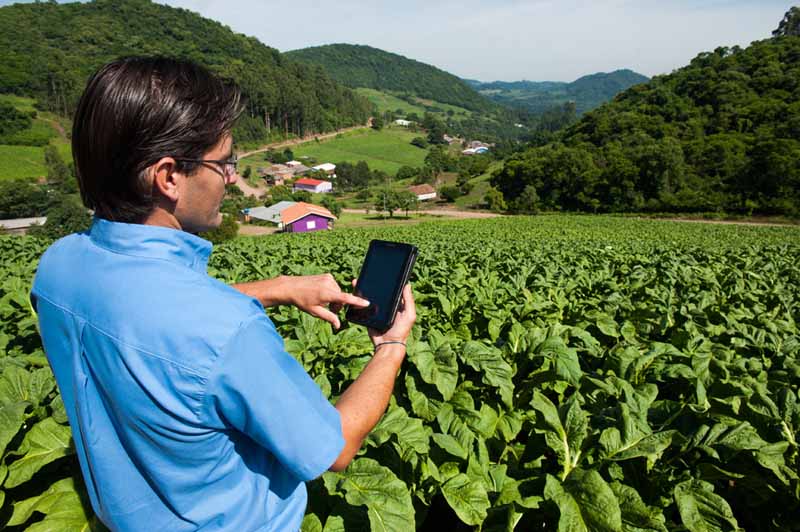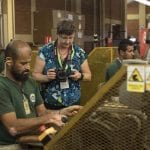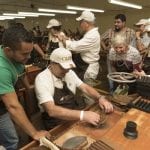Evaluating the challenges and opportunities for leaf tobacco.
By George Gay
If you believe the publicity (and I’m not suggesting you shouldn’t), the route to being a “successful” supplier to the global leaf tobacco trade lies in the direction of consistently producing quality tobacco in a sustainable way and at a competitive price. Fine, but how do you achieve this, given that there are clearly internal conflicts even within the brief guide to success given here?
While pondering this, I decided to ask a number of leaf dealers and traders to rate what the important factors were in maintaining a healthy leaf industry by arranging the following factors in order of importance: (1) easy access to reasonable grower loan facilities, (2) quality seed availability, (3) input availability, (4) grower expertise, (5) grower support, (6) weather/climate, (7) curing fuel availability where appropriate, (8) type of sales system, (9) consistent offtake by buyers, (10) grower prices, (11) export prices and (12) government involvement. From their replies, which are logged in the table on page 30, I awarded 12 points for each time a factor was rated as the most important, 11 points for each time a factor was rated as the second-most important … down to one point for a factor’s being rated 12th most important.
 The results were as follows:
The results were as follows:
56 points: consistent offtake by buyers
56 points: grower prices
56 points: export prices
40 points: grower expertise
39 points: easy access to reasonable grower loan facilities
36 points: input availability
34 points: weather/climate
32 points: grower support
29 points: government involvement
25 points: quality seed availability
25 points: type of sales system
23 points: curing fuel availability where appropriate
In part, some of the things that might seem anomalous here are down to the fact that my question was not specific enough. So, for instance, the fact that “quality seed availability” doesn’t appear higher up the table is not because the experts didn’t think seed was important, but because some of them took the view that seed wasn’t an issue any longer. It had been sorted out some time ago to the extent that just about all tobacco growers now use only quality seed. I assume, too, that with much tobacco being grown as part of a cooperative effort between growers and buyers, “grower support” and, to an extent, “grower expertise” were seen in much the same light by some. And while “weather/climate” might be capable of blighting some seasons, over the long term this factor might be seen as being neutral, though less so, perhaps, in this time of reduced stocks.
“Government involvement” was one factor that split contributors, with some who would welcome more involvement, some who reluctantly accepted that the time of government support was over, and others who wanted governments to have nothing to do with the specifics of tobacco production but who acknowledged that governments had a role to play in providing a stable, predictable environment in which to do business in general.
The biggest surprise to come out of this exercise as far as I was concerned was that “curing fuel availability where appropriate” came out bottom, because, after all, the guide to success at the start of this story mentions sustainable production. In part, the lowly position occupied by curing fuel availability was because two of the experts who took part were involved wholly with sun-cured tobaccos. But even so, this factor was not rated within the top five places by anybody, even though its contribution to sustainability, whether positive or negative, must be huge.
In answering a question about what the current supply/demand situation was in respect of the tobacco types and varieties in which his company was involved, one contributor said, in part, that though all markets were being impacted by changing cigarette consumption, those that were sustainable were likely to be less affected. There was continued pressure on growers “to remain profitable and invest in mechanization to produce crops grown in compliance with environmental and labor standards.”
It will be interesting to see how these issues are resolved in Zimbabwe in the time available given that, under the Sustainable Tobacco Program, starting in 2020, global cigarette companies are expected not to buy leaf tobacco produced in an unsustainable manner. In February, NewsDay Zimbabwe reported that not one tree seedling had been planted in Zimbabwe as part of a government reforestation scheme funded to the tune of $20 million by levies imposed on farmers since 2015.
The bottom line
Meanwhile, I think that it should be of no surprise that the top three places went to “consistency of offtake by buyers,” “grower prices” and “export prices.” Consistency of offtake dovetails nicely with the consistent production mentioned in the guide at the start of this story. And the importance of consistency of offtake was nowhere better illustrated than in India, where a onetime troubled flue-cured tobacco production industry was turned around after buyers stopped using it mainly as a country they went to when supplies from elsewhere failed to meet demand. As I write this piece, a successful—from the point of view of growers and buyers—Karnataka sales season is coming to an end, and what looks like being a successful Andhra Pradesh season is starting.
It is unfortunate, therefore, from the point of view of Indian growers, that while they are at last enjoying the fruits of a relatively stable industry, the authorities are introducing uncertainty by raising the prospect of reducing production in line with the diktats of the World Health Organization’s Framework Convention on Tobacco Control. Such a prospect would not be so negative if it were based on a concrete, rational idea, but it continues to be based on vague promises about pie-in-the-sky, unspecified “alternative” crops and other schemes.
The question of grower prices is a more complex one than is offtake, though the two cannot be separated. Logically, the producer should receive a price that makes it worthwhile to grow tobacco the following season, while the buyer should be able to obtain the tobacco he needs at a price that allows reasonable profits to be made further up the chain. But this supposed balance doesn’t exist in reality, certainly not in all producing countries. This can be clearly seen in Zimbabwe, where sales seasons over the past 20 years have seen grower prices that have fluctuated but that overall have not increased.
The reasons for this state of affairs seem rarely to be looked at, but one buyer who contributed to this report said simply that buyers imposed on growers terms that included stringent grading requirements and poor prices. As an example, farmers in Malawi received low prices on long crops and slightly improved prices on short crops. Over the past 10 years, grower prices for Malawi burley has been between $1 and $2 per kilogram. In addition, farmers were never contracted for more than the current growing season. How, then, could they look at borrowing money to finance their children’s higher education or a mortgage, etc., he asked.
Interestingly, shortly after these comments were made, the Malawi parliament’s agricultural committee asked the Tobacco Control Commission to change its tobacco classification system because, in its view, the current system did not favor tobacco growers.
Managing challenges
In the main, contributors seemed reasonably upbeat about the future of tobacco production, though not oblivious to some very obvious challenges that were being faced and that would be encountered to a greater extent in the future: the fall in the consumption of traditional cigarettes; the rise in the consumption of new nicotine/tobacco products, some without tobacco, some with small amounts of tobacco whose form and blend were different to those of traditional cigarettes; and legislation impacting the consumption of certain types of tobacco. Also raised was the perennial problem of trying to encourage tobacco manufacturers to be more forthcoming in respect of their future requirements.
Burley tobacco, buffeted by a fall in the consumption of American-blend cigarettes and legislation restricting or even banning the use of flavors in cigarettes, seems to be most threatened. Indeed, Alliance One International announced earlier this year that it would not be buying any burley from the U.S. market in the current season. The longtime U.S. leaf tobacco commentator Christopher Bickers reported in his newsletter that Alliance One had put its decision down to sales of cigarettes in the U.S. declining by about 3 percent a year and global cigarette sales following a similar trend. But Bickers suggested that there might be other reasons as well, including perhaps the state of burley inventories and speculation about the U.S. Food and Drug Administration requiring reductions in nicotine yields.
Another threat facing U.S. growers arose during the preparation of this report as China named U.S. leaf tobacco as one of the items on which it might increase tariffs in retaliation for those threatened by the U.S. in respect of certain Chinese goods. China buys from the U.S. mainly flue-cured; tariff increases would be felt almost entirely by growers of this type. And according to a story by Brian Murphy and Zachery Eanes for The News & Observer at the beginning of April, the impact on growers in North Carolina, USA, could be “devastating.” North Carolina exported leaf tobacco worth more than $156 million to China last year, making China the biggest national consumer of the state’s tobacco. Presumably, too, there would be an added if slight impact since China was considering also targeting U.S. cigarette imports.
Outside of this threat, most contributors were not expecting dramatic changes in the production of flue-cured in North America. Nor were they expecting much change in Europe in respect of this type. Change was expected, however, in China and India, where, for a variety of reasons, including increased domestic demand and production controls, the availability of this type of tobacco for export would be reduced. This would mean that South America and Africa would see increased demand for medium- and lower-quality flue-cured. South America would continue to dominate, but Africa, which can provide everything from filler to flavor styles, would become an increasingly strategic area.
In the case of classical oriental tobacco, both the demand and overall volume supply seem to be relatively stable, as they have been for some years, though a huge oversupply of mediocre-quality Izmir tobacco in Turkey is, for the time being, causing severe headaches for merchants, who seem to have been left holding the baby. But within the oriental type, volumes are changing in respect of individual varieties. In the case of Greece’s Basma crop and Macedonia’s Prilep, the mood is good, and production of the former is likely to remain stable while production of the latter might increase (also see “Vote of confidence,” page 20). But in respect of some other varieties, the mood is not so good because of a range of issues to do, directly or indirectly, with prices, an aging farmer base, taxation, labor shortages partly due to urban migration and opportunities provided by other crops. Katerini production is in decline in Greece, Yacca production is falling in Macedonia, and the production of Krumovgrad and other varieties are in decline in Bulgaria. It is possible that the production of some varieties will fall below their tipping point and will eventually disappear altogether. In Turkey, Izmir production will be reduced significantly this year as part of a necessary short-term correction. But while this might impact the size of the grower base, Izmir will remain the dominant variety for the foreseeable future.
One contributor said that he believed that classical oriental needed a good boost provided by a combination of higher green prices, long-term commitments by all sides, participation of governments that includes EU programs and the provision of industry finance for the modernization of tobacco farms and farming methods. Another speculated that classical oriental production could disappear within 20 years.
On a more general level, one contributor cut through the complexities by saying that demand for cigarettes would continue to drop, and so the supply of cigarette tobaccos would have to drop with it. One consequence of this would be that cigarette manufacturers were likely to continue to reduce the complexity in their supply chains by concentrating on fewer origins—origins that offered stability in all its aspects and opportunities for expansion. Once these criteria were met, it would all come down to a question of price: which origins could supply the required tobaccos—mainly medium grades—at the lowest prices while complying with a sustainable program. And what this meant, in all probability, was that, in the main, smaller-scale farmers would move to other crops while larger operators would stay with tobacco.
The writer would like to thank the following contributors to this story:
- Nikos Allamanis, doyen of the Greek classical oriental tobacco industry
- Rainer Busch, principal, NewCo
- Frederick de Cramer, coordinator, Sunel Tobacco
- Graham Kayes, executive vice president of business relationship management and leaf, Alliance One International
- Iqbal Lambat, president and CEO, Star Agritech International
- Grant Readings, Premium Tobacco
- Rick Smith, principal, Independent Leaf Tobacco
- Nikos Tzoumas, MD, Missirian
- John Wallace, principal, Leaf Only

































































